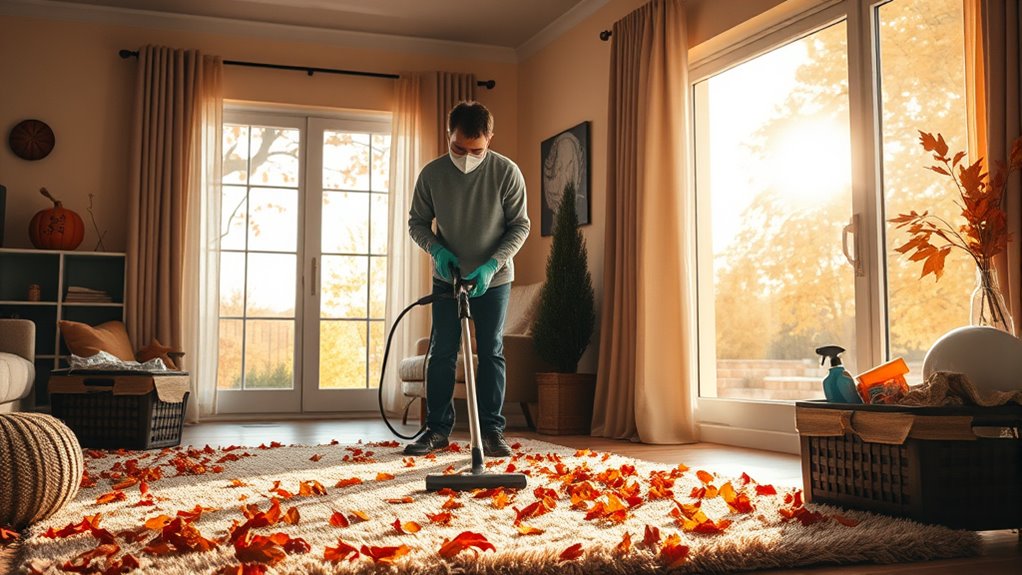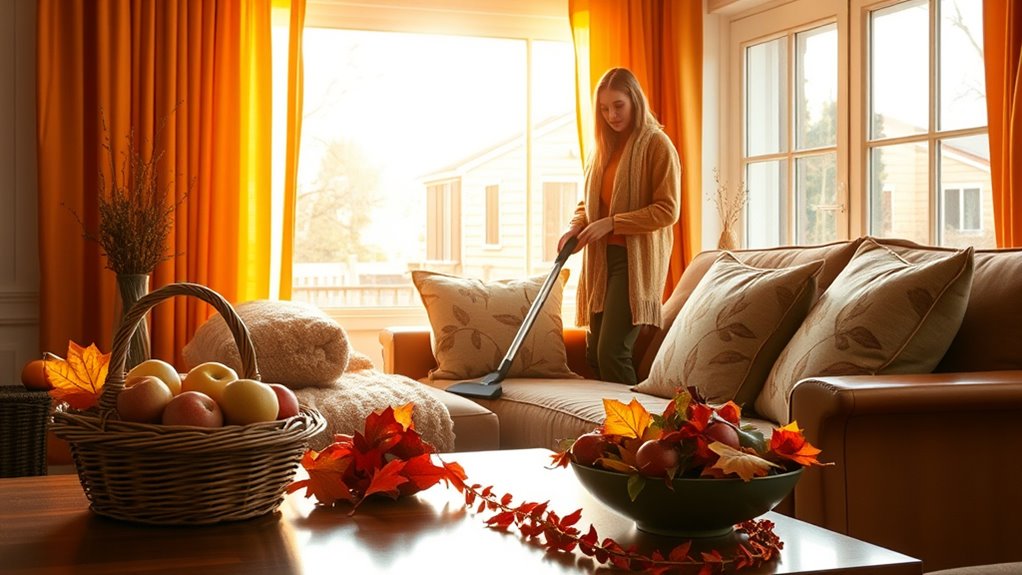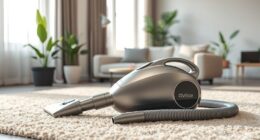To reduce autumn allergies at home, focus on regular cleaning and air purification. Use HEPA air purifiers to trap pollen, mold spores, and dust mites, especially during peak fall season. Wash bedding and curtains weekly, vacuum with a HEPA filter, and keep humidity between 30-50% to prevent mold growth. Minimizing clutter and maintaining a clean environment help limit allergen buildup. Keep exploring, and you’ll discover more effective tips to breathe easier this fall.
Key Takeaways
- Use HEPA air purifiers to filter pollen, mold spores, and dust indoors during fall allergy season.
- Wash bedding, curtains, and clothing weekly to remove allergens and prevent buildup.
- Maintain indoor humidity between 30-50% to inhibit mold growth and dust mites.
- Regularly dust surfaces and vacuum with HEPA filters to reduce settled allergens.
- Minimize clutter and clean vents to prevent allergen accumulation and improve air quality.

As autumn arrives, many people start noticing increased allergy symptoms, often triggered by falling leaves, mold, and dust. During this season, your environment can quickly become a breeding ground for airborne allergens that irritate your lungs and sinuses. One effective way to combat these irritants is by using an air purifier. The air purifier benefits include filtering out pollen, mold spores, and dust particles, helping you breathe easier indoors. By continuously circulating and cleaning the air, it reduces the number of allergens floating around, which is especially important as outdoor allergens peak during fall.
Using an air purifier helps filter allergens and breathe easier during fall allergy season.
Dust mites are tiny creatures that thrive in cozy, warm environments like your bedding, upholstery, and carpets. They’re a common culprit behind allergy flare-ups in autumn. Prevention is key; maintaining a clean environment can considerably reduce dust mite populations. Regularly washing bedding in hot water, vacuuming with a HEPA filter, and minimizing clutter can make a huge difference. An air purifier equipped with a HEPA filter can trap dust mites and their waste particles, preventing them from becoming airborne and inhaled. This not only reduces immediate allergy symptoms but also helps break the cycle of dust mite proliferation altogether.
Cleaning your home thoroughly becomes more critical in fall. Dust, mold spores, and other allergens tend to settle on surfaces, so dusting and vacuuming become essential routines. Focus on areas where dust accumulates, such as under furniture, behind curtains, and in vents. Using a damp cloth rather than a dry duster prevents allergens from spreading into the air. Additionally, consider replacing or cleaning filters in your HVAC system to ensure it’s running efficiently and not dispersing allergens throughout your home. Effective allergen control also involves managing indoor humidity levels to discourage mold growth and dust mite activity.
Don’t forget your clothing and bedding, which can carry allergens into your living space. Washing sheets, pillowcases, and curtains weekly helps eliminate dust mites and mold spores. Keeping humidity levels low—ideally between 30-50%—can inhibit mold growth and dust mite populations. Using a dehumidifier in damp areas like basements or bathrooms can further prevent mold from taking hold.
Frequently Asked Questions
How Often Should I Clean My Air Filters During Fall?
You should check your air filters at least once a month during fall and replace them every 1-3 months, depending on usage and filter type. Regular air filter maintenance is key to fall cleaning routines, helping reduce allergens and improve indoor air quality. Don’t wait until filters look dirty; proactive replacements guarantee your HVAC system runs efficiently and keeps allergy symptoms at bay during the season.
Are Natural Remedies Effective for Autumn Allergies?
Natural remedies like herbal supplements and alternative therapies can help ease your autumn allergy symptoms, but their effectiveness varies. You might find herbal supplements such as butterbur or quercetin helpful, and therapies like nasal irrigation or acupuncture may provide relief. However, it is crucial to consult with a healthcare professional before trying these options, as they work best when combined with your allergy management plan.
What Indoor Plants Help Reduce Allergy Symptoms?
You can brighten your space with allergy-friendly plants like snake plants, pothos, and peace lilies, which are known to improve indoor air quality. These gentle green companions help filter out common allergens, making your home more comfortable. By choosing indoor air quality-friendly plants, you create a healthier environment that supports your well-being. Keep in mind, some plants may still produce pollen, so select those known for their low allergy potential.
Can Changing Clothes Outside Prevent Allergy Triggers?
Yes, changing your clothes outside can help prevent allergy triggers. When you come inside, focus on clothing hygiene by removing outdoor clothing promptly and storing it properly in outdoor storage areas. This minimizes pollen and dust mites from entering your home. Showering and changing into clean clothes also reduce indoor allergens, making your environment less allergy-prone. Incorporate these habits into your routine to effectively lower allergy symptoms during autumn.
How Do I Identify Hidden Mold in My Home?
Think of hidden mold as a sneaky shadow lurking in your home. To find it, perform a thorough mold inspection, focusing on damp, dark areas like behind walls, under sinks, or in basements. Look for discoloration, water stains, or a musty smell. If you suspect hidden mold, consider professional testing. Catching these mold spores early keeps your indoor air safe and your allergies at bay.
Conclusion
By staying on top of your cleaning routine this autumn, you’ll be able to breathe easier and enjoy the season to the fullest. Remember, a clean home is your best shield against allergy triggers. Don’t wait for problems to pile up—tackle dust and debris now before they become a mountain. With a little effort, you’ll be able to turn over a new leaf and make this fall your most comfortable season yet.










